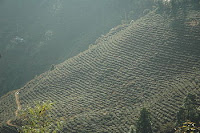
This is an article about the possible health benefits of drinking green and other types of tea from Web MD
Antioxidants in Green and Black Tea
Tea is brimming with antioxidants, the disease-fighting compounds that help your body stave off illness.
By Jeanie Lercher DavisWebMD Weight Loss Clinic-Feature
Reviewed by Brunilda Nazario, MD
Read the tea leaves, caffeine lovers. Tea is gaining ground over coffee. Even Starbucks is bucking up its tea menu. The health benefits of tea are one compelling reason: Green and black teas have 10 times the amount of antioxidants found in fruits and veggies, by one estimate.
Studies of humans and animals show that the antioxidants in black and green teas are highly beneficial to our health, says 82-year-old John Weisburger, PhD, senior researcher at the Institute for Cancer Prevention in Valhalla, N.Y.
"I've published more than 500 papers, including a hell of a lot on tea," says Weisburger, who drinks 10 cups daily. "I was the first American researcher to show that tea modifies the metabolism to detoxify harmful chemicals."
Green tea, black tea, oolong tea -- they all come from the same tea plant, Camellia sinensis. The leaves are simply processed differently, explains Weisburger. Green tea leaves are not fermented; they are withered and steamed. Black tea and oolong tea leaves undergo a crushing and fermenting process.
All teas from the camellia tea plant are rich in polyphenols, which are a type of antioxidant. These wonder nutrients scavenge for cell-damaging free radicals in the body and detoxify them, says Weisburger. "Astounding" aptly describes tea's antioxidant power, he tells WebMD.
"Whether it's green or black, tea has about eight to 10 times the polyphenols found in fruits and vegetables."
Black and green both have different types of antioxidants than fruits and vegetables. Thearubigins, epicatechins, and catechins are among those listed in a USDA chart. All are considered flavonoids, a type of antioxidant. Brewed green and black teas have loads of those, the chart shows. (Herbal teas may also contain antioxidants but less is known about them, Weisburger says.)
"In my lab, we found that green and black tea had identical amounts of polyphenols," he tells WebMD. "We found that both types of tea blocked DNA damage associated with tobacco and other toxic chemicals. In animal studies, tea-drinking rats have less cancer."
Look at the world's big tea drinkers, like Japan and China. "They have much less heart disease and don't have certain cancers that we in the Western world suffer," says Weisburger.
Green Tea, Black Tea: Packed With Antioxidants
"The scientific evidence about tea is evolving and I think it's compelling," Jeffrey Blumberg, PhD, of the Friedman School of Nutrition Science and Policy at Tufts University, tells WebMD.
Tea is a great example of the past decade's research of antioxidants, he says. "There is a pretty consistent body of evidence suggesting there is a benefit to tea. Tea is a very rich source of a specific kind of antioxidant called flavonoids. "
The detoxifying effect of these antioxidants protects cells from free radicals, the damage that can lead to blood clot formation, atherosclerosis, and cancer, says Weisburger.
The bulk of research shows that regular tea drinkers, people who drink two cups or more a day, have less heart disease and stroke, lower total and LDL (often called "bad") cholesterol, and that they recover from heart attacks faster .
Some laboratory tests also show that black and green tea may help boost metabolism to aid weight loss, block allergic response, slow the growth of tumors, protect bones, fight bad breath, improve skin, protect against Parkinson's disease, and even delay the onset of diabetes.
In a study involving bladder cancer cells, green tea extract seemed to make the cancer cells behave oddly. They matured sooner, bound together tightly, and had a hard time multiplying. Another study found that men who drank oolong tea plus green tea extract lost more weight and total body fat, compared with men who drank plain oolong tea. Also, the green tea drinkers had lower LDL cholesterol.
Other small studies have found that the antioxidants from drinking tea can help prevent skin cancer. There's also evidence that tea extracts applied to the skin (in a lotion) can block sun damage that leads to skin cancer.
All this research seems to suggest that if you want to do something good for yourself, drink tea. "It has no calories and lots of polyphenols. If you're drinking tea, you're not drinking soda -- that's a real benefit. Water doesn't give you those polyphenols," says Blumberg.
Weisburger recommends drinking six to 10 cups of black or green tea throughout the day, starting with breakfast. Switch to decaf tea midday, if you need to. "Flavonoids are unchanged by removal of caffeine," he says.
All healthy organic tea available at http://www.omnitea.com/


















 Earl Grey Tea
Earl Grey Tea













